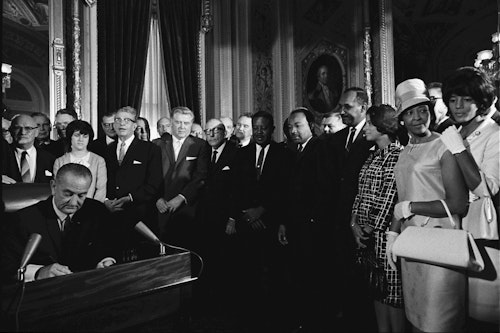The Voting Rights Act

The Constitution guarantees every citizen the right to vote—but that alone has never been sufficient to ensure every American of voting age can exercise it. As we commemorate the 50th anniversary of the Voting Rights Act’s passage, Congress should recognize that though many things have radically changed over the last half century, this right still needs to be vigilantly guarded, not allowed to languish. Members of Congress from both sides of the aisle should recognize the urgent need to pass an update that will replace the formula struck down by the Supreme Court more than two years ago and restore the Voting Rights Act (VRA) to the robust line of defense that has protected every American’s right to vote for the past five decades. There are three reasons we can’t wait.
First, the current law on the books has been gutted. In 2013, the Supreme Court undercut the federal government’s authority to ensure that states and counties don’t enact discriminatory voter laws with its Shelby County v. Holder decision. A majority of the Court struck down Section 4 of the VRA, saying the formula that determined which states or counties needed to “pre-clear” (or get prior approval for) changes to their voting laws was outdated. But the Court also explicitly invited Congress to update this formula to target states and localities with a record of infringing on the voting rights of their citizens in order to make the law work again. Unfortunately, that invitation has been ignored. So right now we are living with a law that has had a massive hole in it.
Secondly, it is clear that though we’ve come a long way on voting rights in our country since 1965, we are a far cry from hanging a “Mission Accomplished” banner. At the time the ruling came down two years ago, 8 states and a significant portion of counties in two others were subject to federal oversight for past voting rights violations. And unfortunately, some states have actively taken advantage of the void created by the combination of the Supreme Court’s decision and Congress’s failure to act. At least a dozen states have enacted restrictive voting laws since the Shelby County case was handed down—sometimes even the same laws that were blocked before the ruling. Texas, for example, immediately announced implementation of a photo ID law that a federal judge had deemed discriminatory when the VRA was intact. Shortly thereafter, Alabama, Arkansas, Mississippi, North Carolina, Tennessee, Virginia, and Wisconsin enacted similar laws. These laws are now being passed despite there being virtually no evidence of voter fraud in this country (one recent study identified 31 cases in over one billion votes) and lots of evidence these laws suppress legitimate votes (one study estimating 5 million votes were not counted in the 2012 election due to registration or identification problems).
Thirdly, the VRA has been and should continue to be deeply bipartisan. The last reauthorization vote passed the Senate 98-0 and the House vote 390-33. Today, Members of Congress as ideologically diverse as Representative Jim Sensenbrenner (R-WI) and Representative Terry Sewell (D-AL) are sponsoring bills to restore the power of the VRA and bring back pre-clearance for states and localities that consistently infringe on the voting rights of their citizens. With such bipartisan agreement on both the problem and the solution, there is no reason Congress can’t act in the coming months.
The VRA worked. In 1965, the African American voter registration rate in Mississippi was less than 7%. After Congress passed the VRA, registration rates climbed to 60.2% within a single year. In order to keep our country moving in the right direction, we must restore this law and ensure that every eligible American can cast their vote and trust that it will be counted.
Subscribe
Get updates whenever new content is added. We'll never share your email with anyone.

